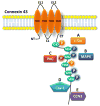Gap junction and hemichannel-independent actions of connexins on cell and tissue functions--an update
- PMID: 24434539
- PMCID: PMC4122521
- DOI: 10.1016/j.febslet.2014.01.001
Gap junction and hemichannel-independent actions of connexins on cell and tissue functions--an update
Abstract
Connexins, a family of transmembrane proteins, are components of both gap junction channels and hemichannels, which mediate the exchange of ions and small molecules between adjacent cells, and between the inside and outside of the cell, respectively. Substantial advancements have been made in the comprehension of the role of gap junctions and hemichannels in coordinating cellular events. In recent years, a plethora of studies demonstrate a role of connexin proteins in the regulation of tissue homeostasis that occurs independently of their channel activities. This is shown in the context of cell growth, adhesion, migration, apoptosis, and signaling. The major mechanisms of these channel-independent activities still remain to be discovered. In this review, we provide an updated overview on the current knowledge of gap junction- and hemichannel-independent functions of connexins, in particular, their effects on tumorigenesis, neurogenesis and disease development.
Keywords: Connexin; Gap junction; Hemichannel; Independent function.
Copyright © 2014 Federation of European Biochemical Societies. Published by Elsevier B.V. All rights reserved.
Figures


Similar articles
-
Gap junction- and hemichannel-independent actions of connexins.Biochim Biophys Acta. 2005 Jun 10;1711(2):208-14. doi: 10.1016/j.bbamem.2004.10.001. Epub 2004 Oct 22. Biochim Biophys Acta. 2005. PMID: 15955305 Free PMC article. Review.
-
Emerging issues of connexin channels: biophysics fills the gap.Q Rev Biophys. 2001 Aug;34(3):325-472. doi: 10.1017/s0033583501003705. Q Rev Biophys. 2001. PMID: 11838236 Review.
-
Role of connexin-based gap junction channels and hemichannels in ischemia-induced cell death in nervous tissue.Brain Res Brain Res Rev. 2004 Dec;47(1-3):290-303. doi: 10.1016/j.brainresrev.2004.08.002. Brain Res Brain Res Rev. 2004. PMID: 15572178 Free PMC article. Review.
-
Regulation of Connexin Gap Junctions and Hemichannels by Calcium and Calcium Binding Protein Calmodulin.Int J Mol Sci. 2020 Nov 2;21(21):8194. doi: 10.3390/ijms21218194. Int J Mol Sci. 2020. PMID: 33147690 Free PMC article. Review.
-
Regulation of gap junction channels and hemichannels by phosphorylation and redox changes: a revision.BMC Cell Biol. 2016 May 24;17 Suppl 1(Suppl 1):11. doi: 10.1186/s12860-016-0099-3. BMC Cell Biol. 2016. PMID: 27229925 Free PMC article. Review.
Cited by
-
Improved multiparametric scrape loading-dye transfer assay for a simultaneous high-throughput analysis of gap junctional intercellular communication, cell density and viability.Sci Rep. 2020 Jan 20;10(1):730. doi: 10.1038/s41598-020-57536-3. Sci Rep. 2020. PMID: 31959888 Free PMC article.
-
Defective lymphatic valve development and chylothorax in mice with a lymphatic-specific deletion of Connexin43.Dev Biol. 2017 Jan 15;421(2):204-218. doi: 10.1016/j.ydbio.2016.11.017. Epub 2016 Nov 27. Dev Biol. 2017. PMID: 27899284 Free PMC article.
-
Introduction: connexins, pannexins and their channels as gatekeepers of organ physiology.Cell Mol Life Sci. 2015 Aug;72(15):2775-8. doi: 10.1007/s00018-015-1958-3. Epub 2015 Jun 18. Cell Mol Life Sci. 2015. PMID: 26084871 Free PMC article. Review. No abstract available.
-
Integration of Migratory Cells into a New Site In Vivo Requires Channel-Independent Functions of Innexins on Microtubules.Dev Cell. 2020 Aug 24;54(4):501-515.e9. doi: 10.1016/j.devcel.2020.06.024. Epub 2020 Jul 14. Dev Cell. 2020. PMID: 32668209 Free PMC article.
-
Connexin 32 downregulation is critical for chemoresistance in oxaliplatin-resistant HCC cells associated with EMT.Cancer Manag Res. 2019 May 31;11:5133-5146. doi: 10.2147/CMAR.S203656. eCollection 2019. Cancer Manag Res. 2019. PMID: 31213923 Free PMC article.
References
-
- Alexander DB, Goldberg GS. Transfer of biologically important molecules between cells through gap junction channels. Curr Med Chem. 2003;10:2045–2058. - PubMed
-
- Goodenough DA, Goliger JA, Paul DL. Connexins, connexons, and intercellular communication. Annu Rev Biochem. 1996;65:475–502. - PubMed
-
- Mesnil M, Crespin S, Avanzo JL, Zaidan-Dagli ML. Defective gap junctional intercellular communication in the carcinogenic process. Biochim Biophys Acta. 2005;1719:125–145. - PubMed
Publication types
MeSH terms
Substances
Grants and funding
LinkOut - more resources
Full Text Sources
Other Literature Sources
Miscellaneous

